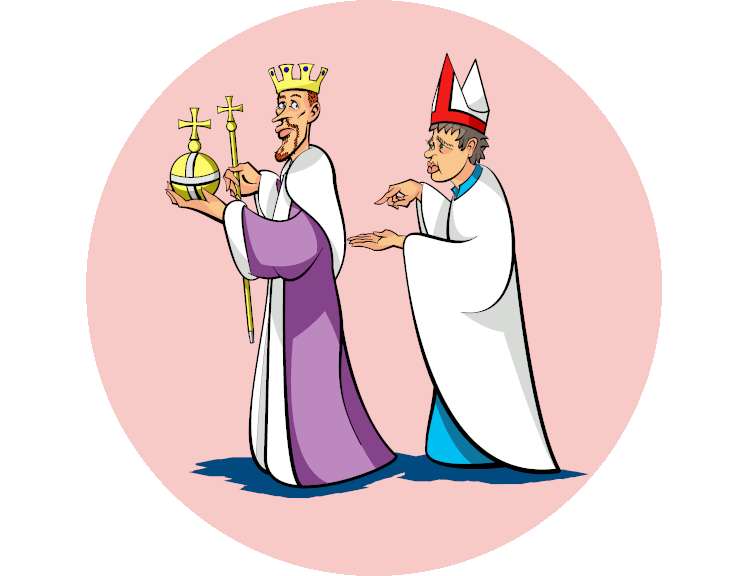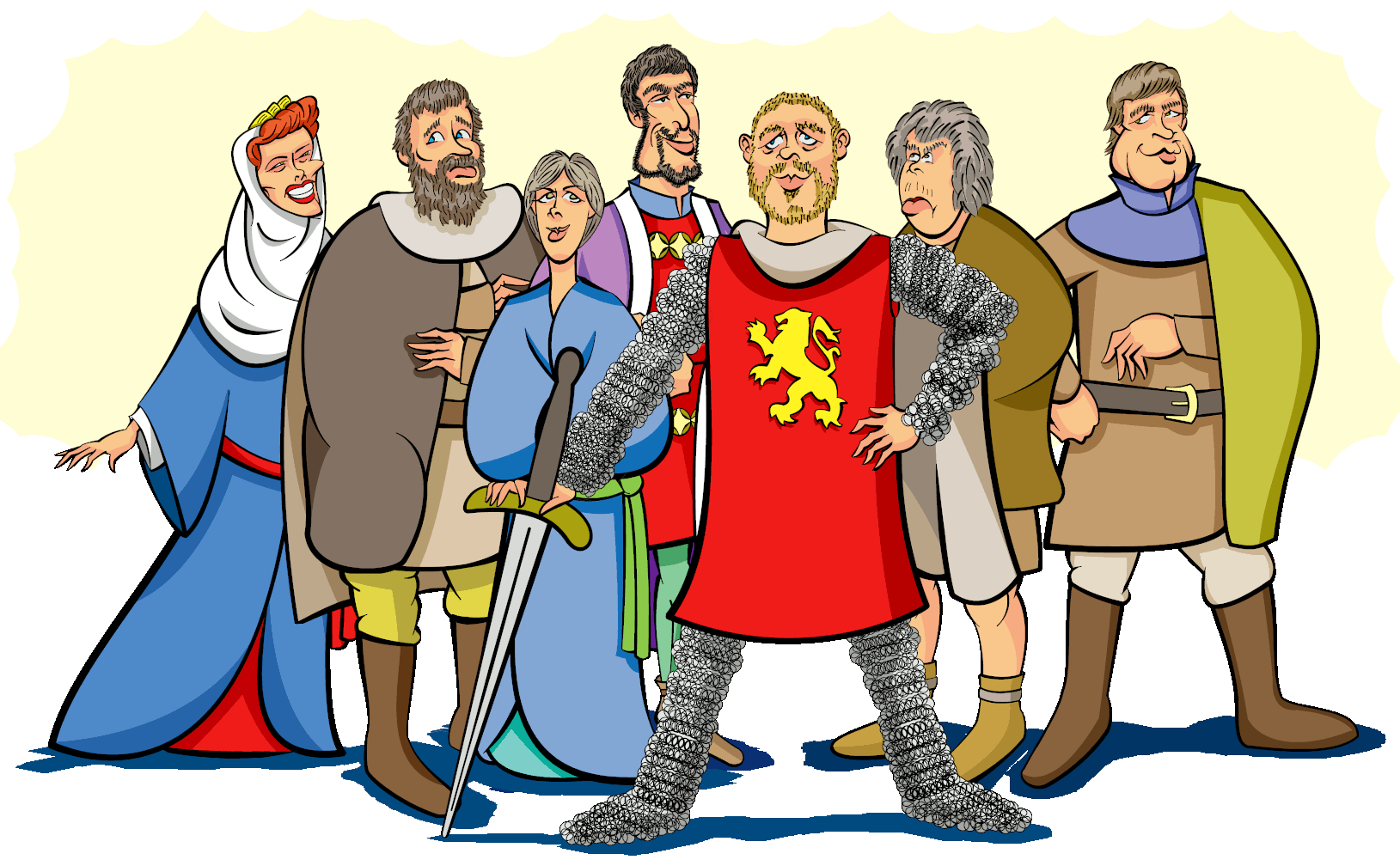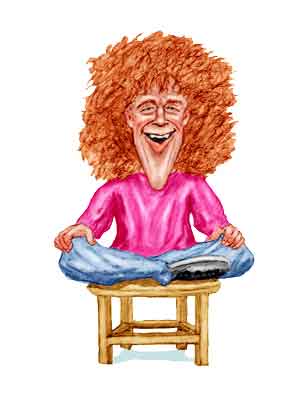Henry II and Thomas Becket

(Click on the image to zoom in.)
Most people who think of King Henry II of England remember Peter O'Toole in the movie The Lion in Winter. Katharine Hepburn played his wife Eleanor of Aquitaine, and their kids were played by - youngest to eldest - Nigel Terry as John, John Castle as Geoffrey, and Anthony Hopkins as Richard the Lionheart. Jane Merrow plays Henry's girlfriend Alais Carpet. Her brother, Phillip II the King of France, was played by Timothy Dalton - now most famous for playing James Bond - in what was his film debut.

The Lion in Winter
Eleanor, Henry, Alais, Phillip, Richard, John, and Geoffrey
(Katharine, Peter, Jane, Timothy, Anthony, Nigel, and John)
But Peter had played the part of Henry before. In 1964 he starred in Becket which was a movie based on the play Becket ou l'honneur de Dieu (Becket or the Honor of God) by Jean Anouilh. The action is set during the years 1155 to 1174, albeit somewhat compressed in the play. As the title makes clear, the play was also about Henry's friend Thomas Becket. Thomas was played by Richard Burton.
The play Becket premiered in Paris in 1959. Although individual scenes were spun out of Jean's imagination, the plot was drawn from real-life events caused by the conflict between what Thomas saw as his religious obligations as Archbishop of Canterbury and his sworn loyalty as a subject of the English king.
As in The Lion in Winter, there's plenty of repartee in Becket. The play starts off with Henry and Thomas - not yet Archbishop - in a conference. During the meeting Henry announces he's reviving the position of Chancellor and appointing Thomas to the post. Thomas is flummoxed.
| Henry: | I have decided to revive the office of Chancellor of England, keeper of the Triple Lion Seal, and to entrust it to my loyal servant and subject Thomas Becket. |
| Becket: | My Lord ... ! | Henry (Roguishly): | What's the matter, Becket? Do you want to go and [!] already? True, we both had gallons to drink last night! |
And as Henry hoped, once Thomas assumes the post he assiduously works for the King's interests.
Then Henry has a great idea. Given the conflict he's had with the Church - such as priests claiming they were immune from secular laws - he'll appoint Thomas as the Archbishop of Canterbury. Now he'll have a friend in the highest ecclesiastical office of the land and who will do his bidding.
But Thomas believes he can't serve both King and God. So he ends up in conflict with Henry and eventually the discord becomes so great that Thomas has to flee to France. Negotiations are made to see if Henry and Thomas can get back on working terms. These events are pretty much what really happened but attempts at any rapprochement between King and Archbishop were unsuccessful.
The trouble is that Henry would meet with Thomas and ask if he would give his loyalty and fealty to the King of England. Of course, Thomas said. He was completely loyal to Henry and would obey all commands of the King in any matter whatsoever.
But then Thomas would always tack on the phrase "saving my order" or "save for the honor of God". This meant he would obey the king in all matters - except if the king's commands were counter to his obligations to the Church. Thomas's qualification would send Henry into spittle flinging diatribes and each meeting would dissolve in acrimony.
Eventually Thomas does return but he keeps claiming independence over Henry in religious matters. Finally Henry has all he can stand and he can't stand no more. As Jean wrote in the play, the King cries out in exasperation:
Will no one rid me of him? A priest! A priest who jeers at me and does me injury! Are there none but cowards like myself around me? Are there no men left in England? Oh, my heart! My heart is beating too fast to bear!
With the king are four barons - knights under the King's service - and they head out and go to Canterbury where they end up confronting Thomas. The call him a traitor and demand he leave the country. Thomas tells them that it is time for the evening service and turns away. The barons then attack Thomas with their swords and leave him dead in the cathedral.
Historically, though, Henry was recorded as saying "What miserable drones and traitors have I nurtured and promoted in my household who let their lord be treated with such shameful contempt by a low-born cleric!" So the knights immediately rode off to Canterbury.
We even know their names: Hugh de Morville, Richard le Breton, Reginald FitzUrse, and William de Tracy. Once at Canterbury they entered the cathedral and found Thomas and demanded he come with them. When he refused they hacked him to death. Unlike many historical events, eye witnesses accounts of the murder have survived and they agree about as well as you can expect.
There was, though, one minor problem in the play. Jean had based his plot on the book Histoire de la Conquête de l'Angleterre par les Normands - The Conquest of England by the Normans - by Augustin Thierry which was first published in 1825. He purchased the book from a stall along the Seine because he thought the green binding would look good on his bookshelf. But first he dipped into the book and found a chapter about the problems Henry II had with Thomas. At the suggestion of his wife, Jean wrote the play which is based on 30 pages from the book.
And in the play we learn Becket was a Saxon - that is, one of the indigenous Englishmen who had been conquered by the Normans in 1066. Henry, of course, was heir to William the Conqueror and so a Norman - that is, a Frenchman and foreign usurper. In the play there is as much a mental anguish caused by Becket being one of the conquered Saxons willingly serving a Norman King as there is between the conflict of the church and state.
Then Jean showed the manuscript to a historian friend who laughed. Yes, he told Jean, early 19th century historians like Augustin did believe Becket was a Saxon. But later research proved he was really a Norman just like King Henry. So a major plot point in the play was based on a historian's error.
At that point the only sensible thing to do was to throw the play out. But Jean decided that if early historians had decided that Becket was a Saxon and later research had shown he was a Norman, he figured more research might prove Becket had been a Saxon all along. Although this has never happened, Becket became a hit play and was produced on Broadway starring Anthony Quinn as Henry and Laurence Olivier as Becket.
As everyone knows, Thomas Becket was canonized in 1173 which was only a little more than two years after his death. Although not the fastest canonization in history, it was still pretty quick. Thomas's tomb became a site of pilgrimage, and Geoffrey Chaucer's Canterbury Tales is about a group of tourists making the trip to Thomas's tomb.
The student of English history may notice that here Thomas has been called Thomas Becket, not as is often the case, Thomas à Becket. Actually in his lifetime there never was an à in the name as we learned from Stephen Fry on the celebrity quiz panel show Qi. Stephen asked the question "What was the name of the archbishop murdered by Henry II?" and Alan answered it was Thomas à Becket. Naturally that set off the klaxons and flashing lights signaling an obvious but incorrect answer.

Stephen Fry
QI

Alan Davies
The Obvious Answer
As usual Stephen pointed out the error:
No, his name was not Thomas "à" anything. The "à" is a complete error. John Strype in The Memorials Of Thomas Cranmer writes "It is a small error, but being so oft repeated deserveth to be observed and corrected. The name of that archbishop was Thomas Becket, nor can it otherwise be found to have been written in any authentic history, record, calendar, or other book. If the vulgar did formerly, as it doth now, call him "Thomas à Becket" their mistake is not to be followed by learned men.
In 1220, fifty years after Thomas died, his bones were removed from their burial place - "translated" is the proper term - and placed in a golden casket behind the high alter in Canterbury Cathedral. His tunic was taken to the Vatican where it remained until returned to Canterbury in 2018. The shrine of Thomas remains one of the most visited sites in England.
But Thomas is not there. In 1536, Henry VIII, ticked off that the Pope wouldn't let him marry Anne Boleyn, began closing down the monasteries (and taking their money). Two years later he declared Thomas had been a traitor and ordered the shrine destroyed. Thomas's bones were burned and the ashes scattered.
And Henry?
Well, he died in 1189 and was buried in the church of Fontevraud Abbey in France near Tours and about 160 miles southwest of Paris. His tomb with his carved effigy is in the western bay of the nave of the church with the tombs of his wife Eleanor, his son Richard, and their daughter-in-law, Isabelle of Angoulême who was the wife Henry and Eleanor's youngest son who eventually became King John of England.
And no, Henry and the others aren't there. At some point their bones were removed and destroyed, possibly during the Hugenot Wars of the 1620's or the French Revolution in 1789.
References and Further Reading
Becket or the Honor of God, Jean Anouilh, (Lucienne Hill, Translator), Perigree Publishers, 1960.
"Thomas Becket: The Murder That Shook the Middle Ages", Lloyd de Beer and Naomi Speakman, British Museum.
"Who Put the 'a' in Thomas a Becket? New Study Sheds Light on the 'Evolution' of the Famous Name", University of York, March 24, 2023.
"Thomas Becket's Bloody Tunic Returns to Canterbury 850 Years After He Died", Catherine Pepinster, The Guardian, November 4, 2018.
"Becket's Bones Return to Canterbury Cathedral", Anglican News, May 23, 2016.
"Tombs at Fontevraud", Angevin Empire, November 8, 2018.
Lion in Winter, Play, William Goldman, Random House, 1966.
Lion in Winter, Screenplay, William Goldman, Dell, Trade Paperback, 1968.
"Campanology", Stephen Fry (host and presenter), Alan Davies (panelist), Bill Bailey, Rob Brydon, Rich Hall, Ian Lorimer (director), John Lloyd (creator and producer), Qi, September 30, 2005.